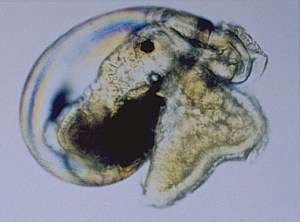Where do their shells come from?
June 6, 1999
From: Jennifer
Yes, Hello.
I have been searching the web for this answer and I just cannot find it. Where do the shells the are inhabited by sea slugs originate from? I understand they are within an embryo while the slug gets ready to leave the shell. I just don't understand if the shell is formed by the slug. I'd appreciate your response.
Thanks,
Jennifer.
BAJROCHE@MSN.COM

Dear Jennifer,
One of the distinguishing features of all molluscs is that they either produce a shell, or have ancestors that produced a shell.
Today many primitive Sea Slugs still have shells. You'll find a list of a variety of 'bubble shells' in the following earlier message. Other pages have photos showing the flattened, very reduced shells of species such as the Sea Hare Aplysia and species of Philine which are in the evolutionary process of 'losing' their shells.
Also have a look at the pages on Torsion and What is a Slug?
Molluscs make their shells by secreting the calcium carbonate from specialised cells at the edge of their mantle, which is a unique flap of skin found only in molluscs. Secretion of the shell begins in the larva, just as embryo humans begin building their bones while still in the womb. Some slugs keep their shell even when they are adults and some discard it at the end of their larval stage. In the Yoshi Hirano's picture alongside, we can clearly see the transparent larval shell of the aeolid nudibranch Facelina bilineata. This shell is retained until soon after the veliger larva settles out of the plankton and begins a benthic crawlng slug. In a few weeks I will be posting a series of Yoshi Hirano's photos showing a veliger settling and dropping its shell.
Why do nudibranchs lose their shell? There is much debate about this, but what we do know is that the loss of the shell gave the Sea Slugs the opportunity to experiment with all sorts of body shapes and to experiment with the brilliant and spectacular colour patterns for which they are so well known.
Best wishes,
Bill Rudman.
